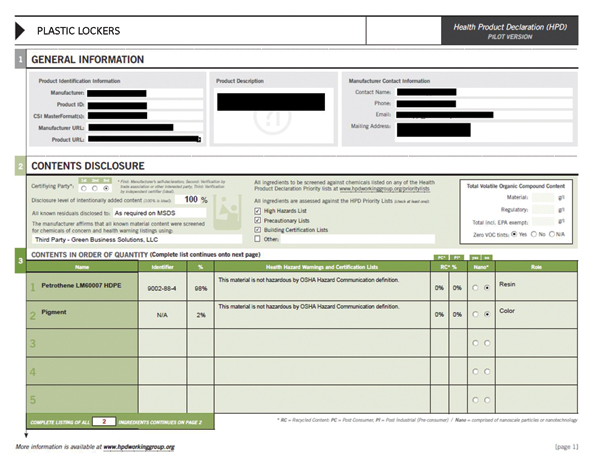The Strong and Sustainable Solution for K-12 School Lockers
Contains Recycled Content
Beyond being fully recyclable, an HDPE locker can contain products that were recycled, which is also referred to as a recycled-content product. This means that the HDPE locker contains items that have been diverted from the traditional waste stream, allowing used items to be re-used in an HDPE locker, instead of ending up in a landfill. The amount of recycled material in a product is typically stated as a percentage. A higher percentage indicates that more of the total product was created from recycled content.
New trends in green building and sustainable design programs are placing a growing emphasis on identifying the stage of use at which the product was sent to become recycled content. This has created different types of recycled content. Most commonly, recycled content is categorized as either post-consumer recycled content or post-industrial recycled content.

Photo courtesy of Scranton Products
Post-industrial/pre-consumer recycled content. For either fun or confusion, two interchangeable terms have emerged to refer to material that is being recycled from manufacturing waste. The two terms are post-industrial and pre-consumer. In either case, it refers to a material that essentially became waste in the manufacturing process of another product and, as such, was never used in an end-user capacity.
HDPE lockers typically contain between 25 percent and 75 percent of post-industrial recycled content. This is again significantly higher than the industry average of post-industrial recycled content found in metal lockers which contain, on average, up to 28 percent post-industrial recycled content.
No Paints, Coatings, Adhesives, Sealants
HDPE lockers are manufactured from a solid plastic material. These lockers do not employ paints, coatings, adhesives, or sealants of any kind. The solid lockers do not emit or off-gas any volatile organic compounds (VOCs) over the course of their usable life.
Significantly Reduce Interior Noise Pollution
The resounding slam of a metal locker is the soundtrack for many school day memories, but new emphasis on acoustical control in the school environment could incentivize designers to minimize the noise pollution created at the locker. Recent tests measured the noise level created by the normal operation of a metal locker at 81 decibels(dB). To put that into context, the American Tinnitus Association identifies an alarm clock (2 feet away) as having a sound level of 80 dB. Alternatively, the noise level created by the normal operation of an HDPE locker was measured at just over 74 dB. This noise level is considered similar to that created by a washing machine or an average radio volume.
In terms of reducing potential noise pollution in the indoor environment, specifying HDPE lockers in a school corridor, instead of metal lockers would create a material difference. It is the difference between a hallway filled with buzzing alarm clocks or a hallway filled with whooshing washing machines. Renee Rudd, principal, Central Valley Academy High School, Ilion, New York, noticed a significant change in the amount of noise in the hallway after the metal lockers were replaced by HDPE lockers. “Before, the hallways were always filled with the metal-on-metal clatter of the locker doors opening and shutting. Now, you don't hear that. You hear the kids talking and you hear movement in the hallway, but you don't hear the rustle of lockers that you used to hear. It is much better.”
Content Transparency
In the quest to create healthier spaces, designers want to know if a product poses a potential risk to the health and well-being of building occupants. They want to know if a product could negatively affect the interior environment and potentially cause an adverse reaction in a person who comes in contact with a product or spends time in the general area of a product. For example, there are thousands of products currently available for specification that emit VOCs, some of which, according to the Environmental Protection Agency (EPA), may have short- and long-term health effects. Designers want to be able to consider the potential health impact of a product, before it is specified into a building they are designing.
In response to these rumblings, another aspect of sustainable design gaining momentum is the demand to improve visibility to the potential health impacts that a product may have on building occupants. Non-profit organizations and manufacturers are developing health disclosure tools that highlight the potential impact a product may have on human health and well-being. One of the first health disclosure tools on the market was the Health Product Declaration™ (HPD).

Photo courtesy of Scranton Products. Danville Elementary School, Danville, PA.
Both the HDPE resin and the pigment ingredients in an HDPE locker have been classified as not hazardous by the OSHA Hazard communication definition.
The HPD contains an itemized list of the ingredients contained within a product and communicates whether or not any particular ingredient has been identified as hazardous or of concern. It should be noted that while the HPD attempts to convey whether or not the product contains any ingredients identified as hazardous, it stops short of addressing whether or not the use of a chemical in a product represents a meaningful risk to the people or the environment. This is an important distinction to make, because it is possible for a product to contain a hazardous material, but present no real risk to the health or well-being of the people manufacturing the product or the finished interior that contains the product. Nonetheless, the HPD does provide improved product transparency in terms of presenting the product contents and is a tool that specifiers, design teams, and building owners can use to make more informed decisions in choosing building products that contribute toward creating a quality interior environment and promoting the health and well-being of its occupants.
Health Product Declaration (HPD). In November 2012, the first open standard format for reporting content and hazards in building products was launched by the Health Product Declaration Collaborative. The Health Product Declaration™ (HPD) Open Standard Version 1 is a standard format that building manufacturers can use to convey the details about hazardous product content, emissions, and associated health information needed by building designers, specifiers and owners to make more informed decisions during product selection.

The HPD gives specifiers visibility into the contents of a product and the potential impact that those ingredients may have on the health and well-being of building occupants.
The HPD is designed to improve the transparency of product contents and facilitate conversations between manufacturers and the specification community about the impact that material selection can have on the quality of the interior building environment and the health of its occupants. The standard reporting format reduces redundant, and sometimes conflicting, reporting formats that product manufacturers have been managing, provides a clear definition of what constitutes disclosure of product contents, and assists interested parties in comparing the formulations of different products.
While still relatively new to the building industry, an HPD can already be used to satisfy various green building initiatives and is gaining traction in the design and specification community as an important resource to reference when considering which products to specify onto a project. The HPD has been identified as an acceptable pathway for the “Building Product Disclosure and Optimization-Material Ingredients” credit in the green building rating system LEED™ v4, as approved by USGBC members.
HPDs are increasingly being required by design firms, finished product manufacturers, architects and builders, with some members of the design community mandating that products in their library or included in their projects must provide full content transparency.
HPD report contents. A product HPD is comprised of five sections: general product information, product content in descending order of quantity, applicable testing and certifications, accessory materials, and notes. The fundamental purpose of the HPD is to give visibility to the contents of a product and the health hazards associated with those ingredients. The report recognizes two types of contents: intentional ingredients and residuals. Intentional ingredients are defined in the HPD Standard as each discrete chemical, polymer, metal, bio-based material or other substance added to the product by the manufacturer or suppliers that exist in the product as delivered for final use. Residuals that should be disclosed are defined in the HPD Standard as known trace substances remaining in the product from manufacturing steps or contaminants that come with raw materials. This may include residuals known from testing as well as those estimated as likely from assessment of process chemistry.
In an HPD, there is an entry line for each intentional ingredient and residual, essentially creating an inventory of the product contents. Standardized reporting elements for each ingredient include: substance name, the Chemical Abstract Service Registration number, also referred to as the CAS number, the ingredient's percentage of the final product by weight, GreenScreen® benchmark, recycled content, whether or not the product is comprised of nanoscale particles or nanotechnology, and the role or function of the ingredient in the product.
Each ingredient and residual is then screened for health and environmental hazards against a minimum set of authoritative chemical hazard lists defined as the HPD Priority Lists. The HPD Priority Lists are comprised of the chemical hazard lists that inform the GreenScreen® for Safer Chemicals methodology and includes lists that address ozone depletion, global warming, pollution, and halogenated flame retardants. Any health hazards, warnings, or appropriate GreenScreen Benchmark abbreviations identified from these authoritative lists must be listed next to the ingredient in this section in the HPD.
The HPD of HDPE. HPDs for HDPE products have been completed by third-party certifiers providing full disclosure of product contents and finding that the HDPE ingredients do not pose any known health hazards and do not require a warning of any kind.
An HDPE product, such as an HDPE locker, may have as few as two intentional ingredients to list in the HPD. They are the specific HDPE plastic used as the resin for the product and the pigment used to color the product. Once the ingredients have been identified and listed on the HPD, the certifying party will then assess the listed product ingredients against multiple HPD priority lists identifying compounds that have been shown to be potentially hazardous.
HDPE resin does not appear on any of the authoritative lists referenced to identify hazardous compounds and, subsequently, the HDPE resin is classified as non-hazardous. Specifically, per the HPD Collaborative, HDPE resin is classified as “hazard range low” for GreenScreen Group I Human Health Effects, which evaluates ingredients for carcinogenicity, mutagenicity/genotoxicity, reproductive toxicity, developmental toxicity, developmental neurotoxicity and endocrine activity. HDPE resin is also classified as “hazard range low” for GreenScreen Group II Human Health Effects, which evaluates ingredients for systemic toxicity/organ effects, including immune system effects, neurotoxicity, respiratory sensitization, skin sensitizations, ecotoxicity, flammability and reactivity.
Some HPDs are completed at a level of disclosure required by a Material Safety Data Sheets (MSDS). An MSDS is a document that contains information on the potential hazards of a product in terms of the health, fire, reactivity, or environmental hazards it may present. It is intended to identify what the hazardous ingredients are, how to use the product safely, and what to do if accidents occur and how to recognize symptoms of overexposure. The Federal Occupational Safety and Health Administration (OSHA) Hazard Communication Standard (29 CFR 1910.1200) requires manufacturers of chemicals to issue MSDSs. In prior HPDs completed for HDPE products, that were completed “as required on an MSDS”, both the HDPE resin and the pigment are described as “not hazardous by the OSHA Hazard Communication definition.”









